Introduction
The CPU market has been relatively noncompetitive for the past few years, but AMD is bouncing back into competition against Intel with its Ryzen series of central processing units (CPUs). Ryzen is based on AMD’s new Zen architecture and uses the company’s new AM4 socket type. This is the direct successor to AMD’s AM3 and AM3+ socket types, which launched in 2009 and 2011, respectively. The last consumer-level CPUs from AMD were with its FX line and the Piledriver architecture, which released in 2012.
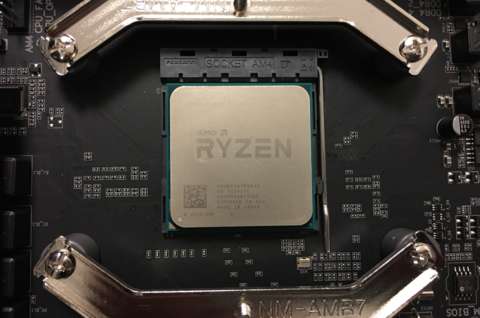
The Ryzen 7 family is AMD’s high-end CPU line, all equipped with eight-cores and 16 threads. We’re specifically reviewing the highest-end 1800X model here. It runs at a base clock speed of 3.6 GHz and a boost clock of 4.0 GHz. At $499 USD, the Ryzen 7 1800X is aimed at those who are in the market for a CPU that’s competent for gaming, but built to handle multi-core tasks like video production and streaming. It aims to represent a blend of professional use-case scenarios with relative consumer affordability. The buzzword associated with this growing market is “prosumer.” The 1800X is also significantly cheaper than Intel’s eight-core i7-6900K ($1,049 USD) and the company’s leading 10-core i7-6950X ($1,649), and priced just above the six-core i7-6800K ($409), all of which are from Intel’s 14nm Broadwell-E architecture.
- Introduction
- Technical Details
- Methodology
- Benchmark Results
- Blender
- Cinebench R15
- GeekBench 3.0 Multicore 64-bit
- GeekBench 3.0 Single-Core 64-bit
- PCMark 8 Creative Accelerated
- 3DMark 11 Extreme Physics Score (1080p)
- 3DMark 11 Performance (720p)
- POV-RAY 3.7
- POV-RAY 3.7 (Single-Core)
- X264 pass 1
- X264 pass 2
- 7-Zip
- Star Swarm Stress Test (Low at 1080p)
- Star Swarm Stress Test (Extreme at 1080p)
- BioShock Infinite (Low at 1080p)
- BioShock Infinite (Max at 1080p)
- SteamVR
- Temperatures and Overclocking
- Conclusion
Ryzen 7 Line of CPUs
| CPU | Cores, Threads | Socket | Base Clock | Boost Clock | TDP | MSRP |
|---|---|---|---|---|---|---|
| 1800X | 8 cores, 16 threads | AM4 | 3.6 GHz | 4.0 GHz | 95W | $499 |
| 1700X | 8 cores, 16 threads | AM4 | 3.4 GHz | 3.8 GHz | 95W | $399 |
| 1700 | 8 cores, 16 threads | AM4 | 3.0 GHz | 3.7 GHz | 65W | $329 |
Technical Details
AMD’s new Zen architecture adopts the 14nm FinFET technology which is much more power efficient compared to the previous Piledriver architecture’s 32nm SOI manufacturing process. The thermal power design (TDP)--aka power draw--of the Ryzen 7 1800X is 95W, and can ramp up the wattage to the AM4 limit of 128W under an “all cores boost” heavy load case, which it does automatically when there’s enough thermal headroom.
Socket AM4 is also introduced along with Ryzen CPUs, which will feature six different chipset options. The X370, B350, X300 (for small form factor) chipsets will allow for unlocked overclocking on any of the Ryzen CPUs. The following are the details for all the chipsets:
| Chipset | USB (3.1 G2, 3.1 G1, 2.0) | SATA | DDR4 DIMM Slots | PCIe Lanes | PCIe Slots | Overclocking |
|---|---|---|---|---|---|---|
| X370 | 2, 6, 6 | 4 | 4 | 8, Gen 2 | 2 | Unlocked |
| B350 | 2, 2, 6 | 2 | 4 | 6, Gen 2 | 1 | Unlocked |
| A320 | 1, 2, 6 | TBA | TBA | 4, Gen 2 | 1 | Locked |
| X300 (SFF) | TBA | 2 | 2 | TBA | 2 | Unlocked |
| A/B300 (SFF) | TBA | TBA | TBA | TBA | 1 | Locked |
A single Zen CPU Complex (CCX) contains four cores, eight threads, 64Kb L1 instruction and data caches, 512KB dedicated L2 cache per core, and an 8MB L3 cache shared among all CPU cores. Zen-based products can feature multiple CCXs, and in the case of Ryzen 7, two CCXs are on the processor.
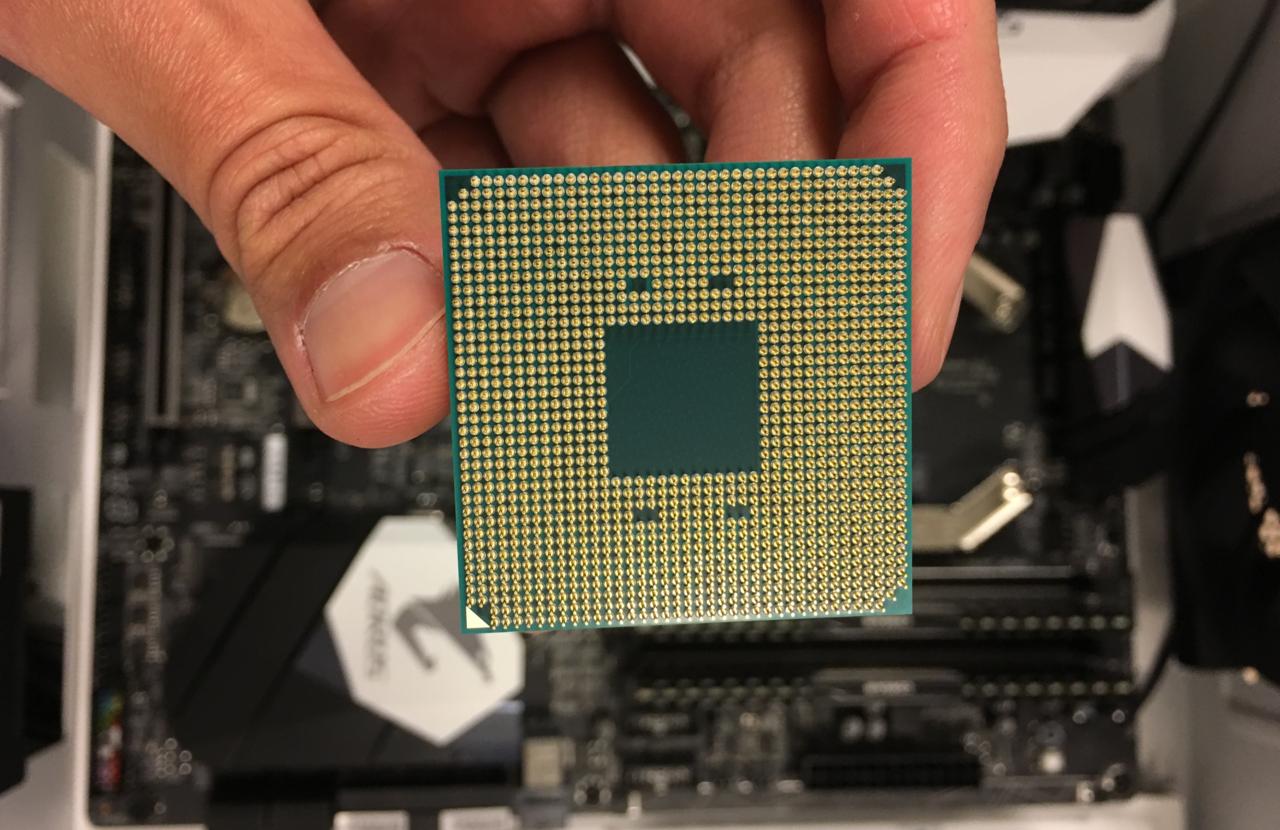
Along with the new Zen platform, AMD introduces new technologies such as SenseMI, XFR, Precision Boost, and the AMD Ryzen Master software. SenseMI detects and reads the CPU's behavior and allows Precision Boost to work, which varies core clock speed in increments of 25 MHz on the fly. XFR (only available on X-branded Ryzen CPUs) recognizes how efficient your cooling solution is and ramps up clock speeds beyond the boost level, if enabled. Lastly, the AMD Ryzen Master software is an application that allows users to control clock speed, voltages, and monitor CPU activity.
Methodology
Test Bench
Our test bench for the Ryzen 7 1800X consists of the Gigabyte AX370 Gaming 5 motherboard for socket AM4 CPUs, 16GB (2x8GB) of Corsair Vengence DDR4 3000MHz dual-channel RAM, and a Noctua NH-U12S CPU cooler. To keep things as consistent as possible with our previous CPU tests, we stuck with a reference Nvidia GTX 980 as our graphics card. We were also equipped with a 700-watt NZXT power supply and a Western Digital Blue SATA solid-state drive. Here is a chart for the specs of the systems used in our tests:
| CPU | AMD Ryzen 7 1800X | Intel Core i7-6950X | Intel Core i7-5960X | Intel Core i7-7700K | Intel Core i7-6700K |
| Motherboard | Gigabyte AX370 Gaming 5 | Asus Strix X99 Gaming | Asus Strix X99 Gaming | Gigabyte GA-170X-Gaming 7 | Gigabyte GA-170X-Gaming 7 |
| RAM | Corsair Vengeance 3000MHz | Corsair Vengeance 2133MHz | Corsair Vengeance 2133MHz | Corsair Vengeance 2133MHz | Corsair Vengeance 2133MHz |
| GPU | GeForce GTX 980 | GeForce GTX 980 | GeForce GTX 980 | GeForce GTX 980 | GeForce GTX 980 |
| SSD | WD Blue 960GB | Corsair Force LS 240GB | Corsair Force LS 240GB | Seagate 600 Series 240GB | Seagate 600 Series 240GB |
| CPU Cooler | Noctua NH-U12S (Air) | Corsair H115i | Corsair H115i | NZXT Kraken X61 | NZXT Kraken X61 |
| Case | NZXT H340 | Corsair Carbide 600C | Corsair Carbide 600C | NZXT H440 | NZXT H440 |
| Power Supply | NZXT 700W | Corsair RM850X | Corsair RM850X | NZXT 1200W | NZXT 1200W |
All systems ran on Microsoft Windows 10 operating system.
Approach
All the results used in our charts for this review are based on numbers produced by GameSpot. Tests were conducted and recorded internally across all CPUs. The majority of our benchmarks are focused on stressing the CPU for both single and multicore performance. In this review, we found it relevant to use our numbers from our previous tests with the Intel Core i7-6700K, 7700K, 5960X, and 6950X for comparative purposes. Here are the specifications of each CPU:
| CPU | Cores, Threads | Base Clock Speed | Boost Clock Speed | Chipset | TDP |
|---|---|---|---|---|---|
| AMD Ryzen 7 1800X | 8 cores, 16 threads | 3.6 GHz | 4.0 GHz | X370 | 95W |
| Intel Core i7-6950X | 10 cores, 20 threads | 3.0 GHz | 3.5 GHz | X99 | 140W |
| Intel Core i7-5960X | 8 cores, 16 threads | 3.0 GHz | 3.5 GHz | X99 | 140W |
| Intel Core i7-7700K | 4 cores, 8 threads | 4.2 GHz | 4.5 GHz | Z170 | 91W |
| Intel Core i7-6700K | 4 cores, 8 threads | 4.0 GHz | 4.2 GHz | Z170 | 91W |
Benchmark Results
Blender
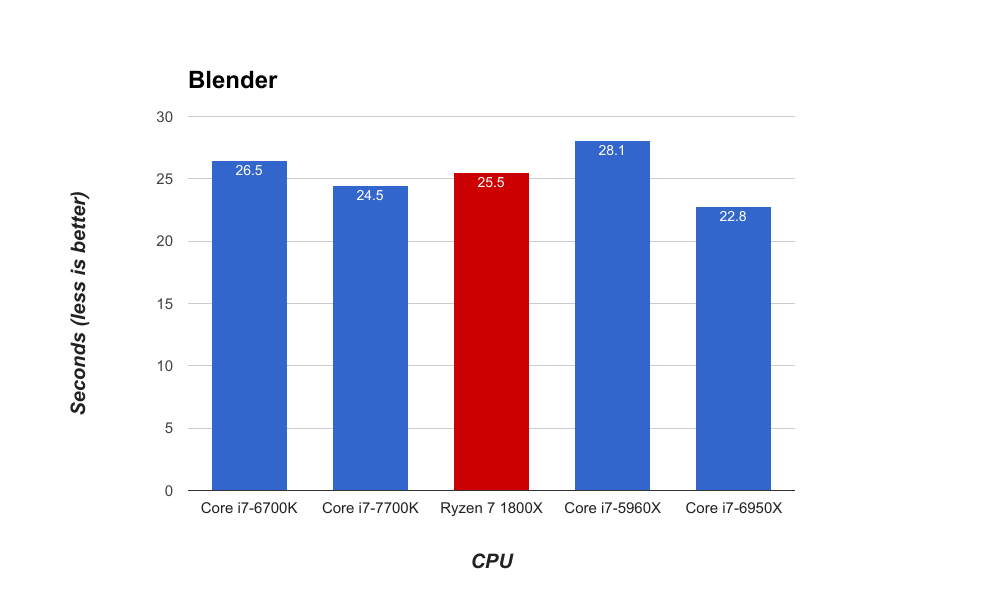
Blender is an open-source 3D graphics and animation program that really stresses multi-core CPUs. Just like our previous tests, we used the “flying squirrel” 3D model to render in Blender. Per our results, the 1800X was outperformed by the 7700K by four percent. This would indicate that Blender doesn’t need more than four cores to run efficiently, backed up by the slower performance of the 5960X. The 6950X does come out on top, however. This could be due in-part to Broadwell-E’s Max Turbo Boost feature.
Cinebench R15
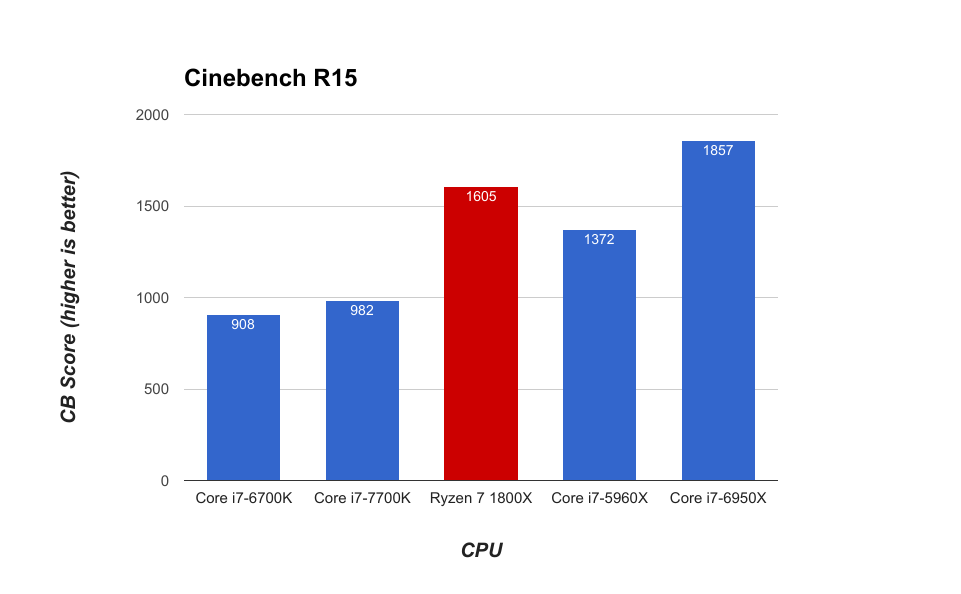
Cinebench R15 is a 3D animation benchmark that really makes the most of CPU cores. We see the 6700K and 7700K lag significantly behind while the eight and ten core CPUs exhibit substantial improvement. Considering the price of the 1800X, Cinebench shows it to contend with the more expensive ten-core 6950X by being 13.5 percent slower. The 1800X zooms past the 7700K by performing 39 percent faster.
GeekBench 3.0 Multicore 64-bit
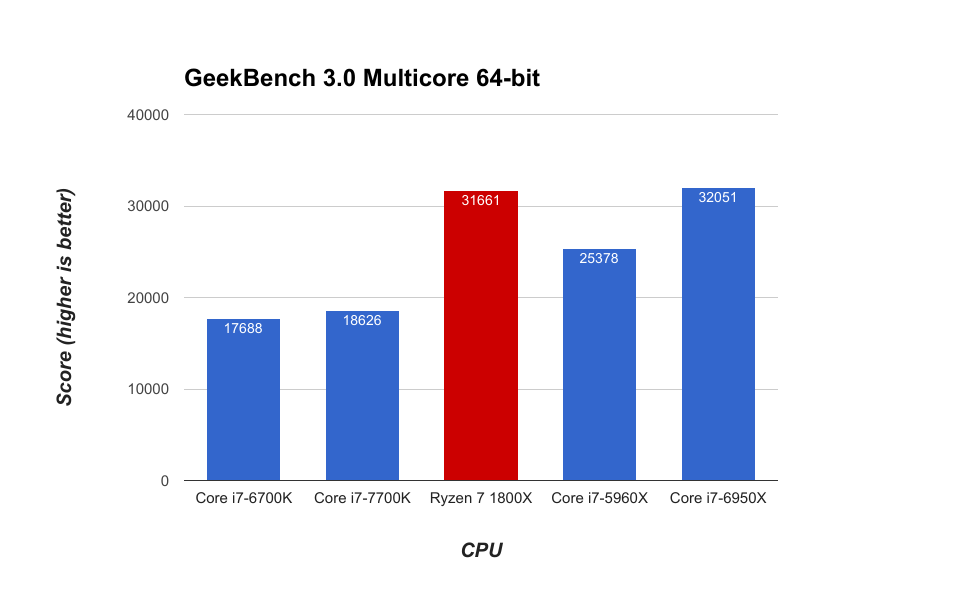
GeekBench 3.0 is a synthetic benchmark that scores CPU power. The 1800X has an impressive showing in the multicore test, coming within one percent of the 6950X. It also leaps well ahead of the 5960X by nearly 25 percent, showing the advantage of its two extra cores.
GeekBench 3.0 Single-Core 64-bit

As expected, the 7700K and 6700K shine in this test with their more robust individual cores. However, the 1800X makes a significant statement of single-core efficiency by jumping well ahead of the 6950X with its higher clock speeds.
PCMark 8 Creative Accelerated

PCMark 8 is a multi-step test that simulates real-world scenarios like video conferencing, web browsing, and photo editing. This is one case where Ryzen leaps ahead of all the other intel processors by performing nearly four percent faster than the four-core and and ten core CPUs. Having extra cores doesn’t lead to a clear advantage in this test, but the efficiency of the 1800X shows it’s well-suited for everyday applications.
Since we’ve used data from previous benchmarks, the anomaly between the 6700K outperforming the 7700K persists. The test was done twice at that time and the results remained the same.
3DMark 11 Extreme Physics Score (1080p)

3DMark 11 is a synthetic DirectX 11 benchmark tool that gives users an idea of how a system will perform in games. With the Extreme test, we only took the physics score to see how our CPUs handled complex physics calculations. While the 1800X leads the four-core i7s by nearly eight percent, the eight and ten-core Intel CPUs exhibit a substantial lead.
3DMark 11 Performance (720p)
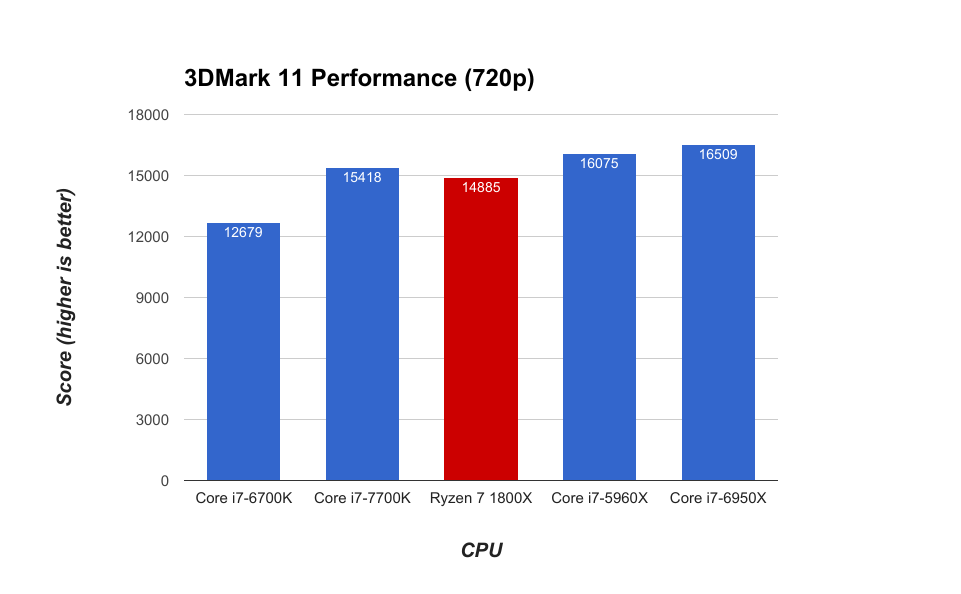
By running the 720p 3DMark 11 test, we get a larger picture while leaning more on the CPU. Our Ryzen 7 1800X beats out the 6700K by about 17 percent, but still trails the 7700K by about four percent and the 6950X by ten percent. The takeaway is that this benchmark isn’t intended to take full advantage of additional cores.
POV-RAY 3.7

Persistence of Vision Raytracer (POV-RAY) is a free benchmark that tests a system’s ray tracing capability. The results show that extra cores make for a distinct advantage in ray tracing. We see the 1800X well ahead of the four and eight-core Intel CPUs, but just behind the ten-core 6950X.
POV-RAY 3.7 (Single-Core)

The single-core results breakdown as expected, with the 6700K and 7700K showing better individual core performance. The 6950X does edge out the 1800X in this case by a little over five percent, however.
X264 pass 1
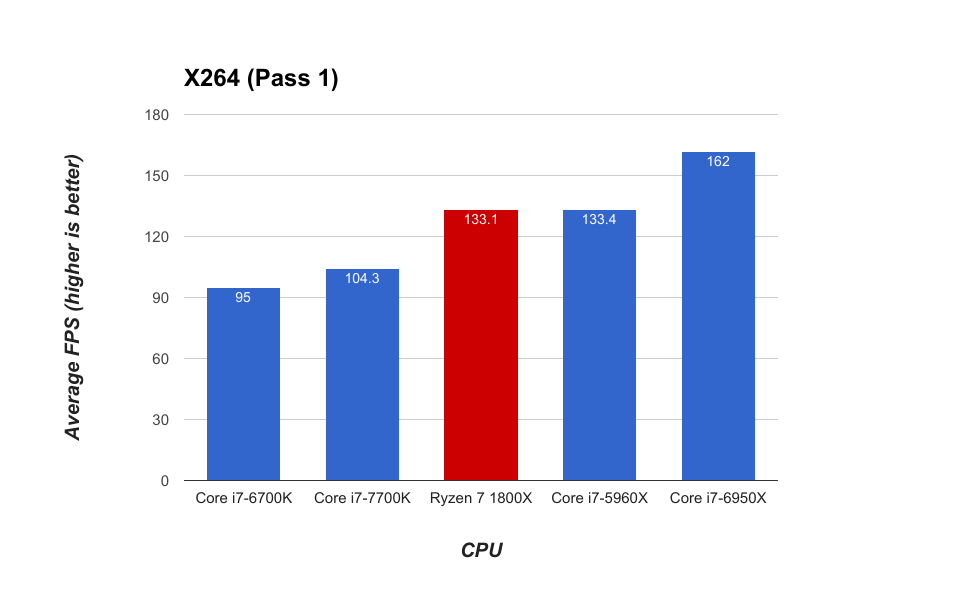
The Tech ARP X264 benchmark is one of the most demanding CPU tests, which consists of two passes in a single run to simulate video encoding. Core count is a significant advantage in X264 and it shows with the 1800X, 5960X, and 6950X speeding ahead of the four-core i7 CPUs.
X264 pass 2
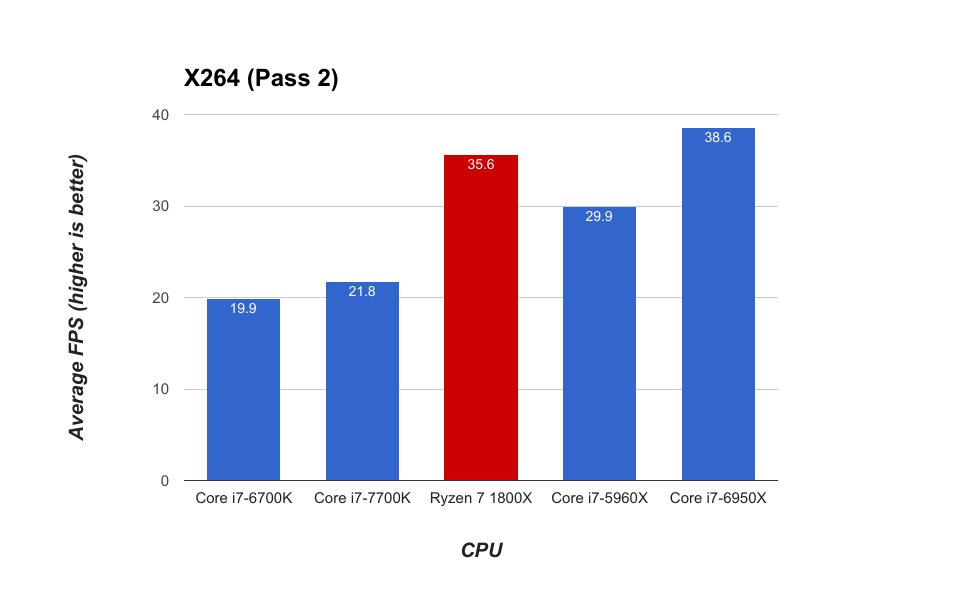
The advantage of core count becomes more clear when things get more intense in the second pass of X264. The 1800X trails just behind the ten-core 6950X by around seven percent, and overtakes the eight-core 5960X by about 16 percent. The 7700K and 6700K lag behind and proves that video encoding is best done with more cores.
7-Zip
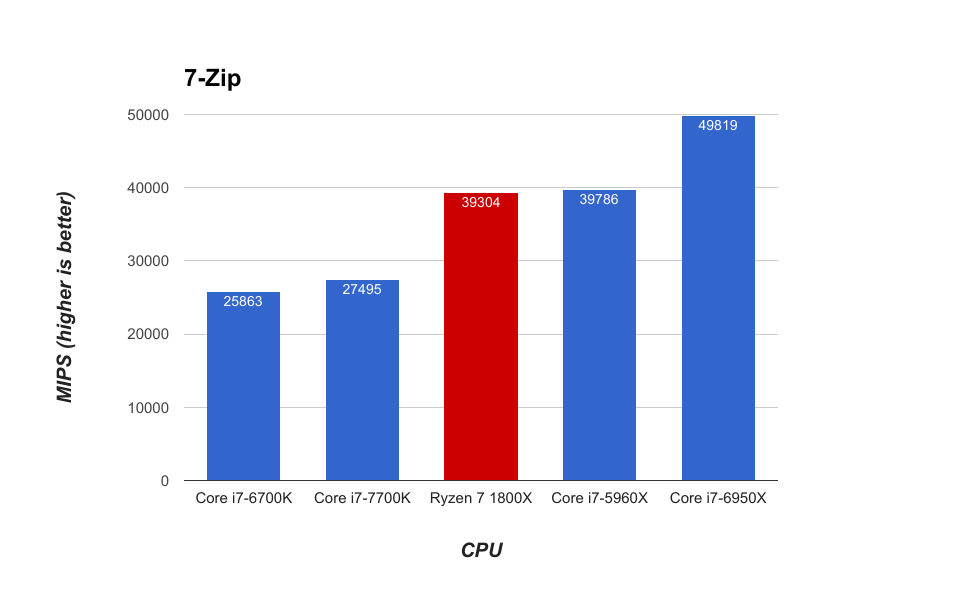
7-Zip is one of the most common compression and decompression tools available. These tasks rely heavily on the CPU and clearly takes advantage of extra CPU cores. In this case, we see the 1800X in a virtual tie with the 5960X while the 6950X speeds past both.
Star Swarm Stress Test (Low at 1080p)

The Star Swarm Stress Test is a real-time tech demo from Oxide games, co-developers of the RTS Ashes of the Singularity. Testing at low settings shifts the emphasis from the GPU to the CPU, and this particular test is partial to extra cores. However, the 1800X doesn’t react well to the benchmark compared to the Intel CPUs. It trails behind the 6700K by about six percent and the rest by about 23 percent. The 6950X and 5960X do show a distinct advantage over the four-core i7 CPUs, though.
Star Swarm Stress Test (Extreme at 1080p)

The 1800X still struggles to keep up with the Intel CPUs, even dipping below 60 FPS when we bump the settings up to extreme quality. Extra cores still exhibit a substantial benefit among the Intel CPUs, so it’s curious to see the 1800X come up short.
BioShock Infinite (Low at 1080p)
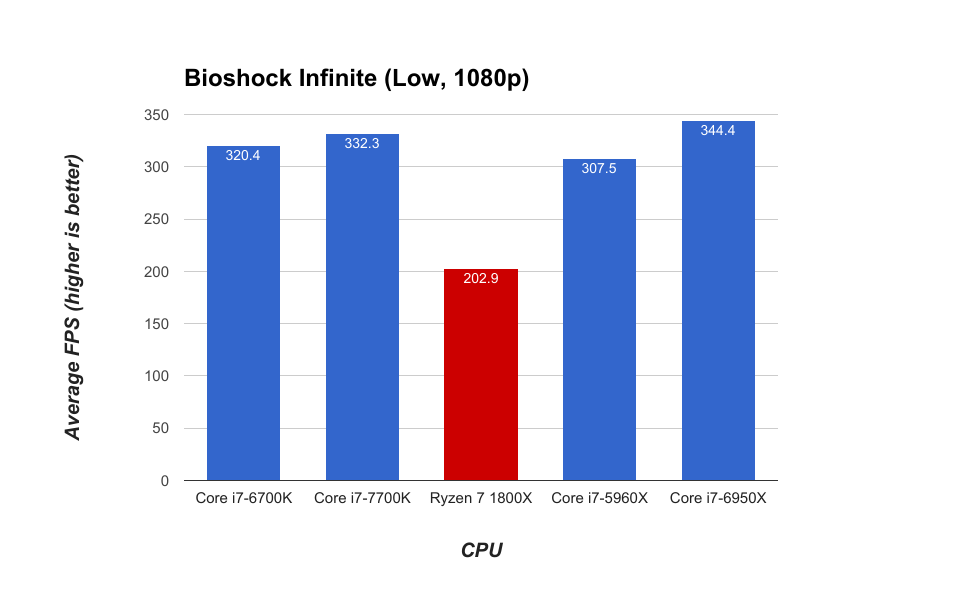
We continue to see the 1800X significantly lag behind when we move to the Bioshock Infinite benchmark tool. While all Intel CPUs put out 300+ FPS at low quality settings, the 1800X averages just above 200 FPS. The 6950X leads the performance pack a bit, but the 6700K and 7700K aren’t far behind.
BioShock Infinite (Max at 1080p)
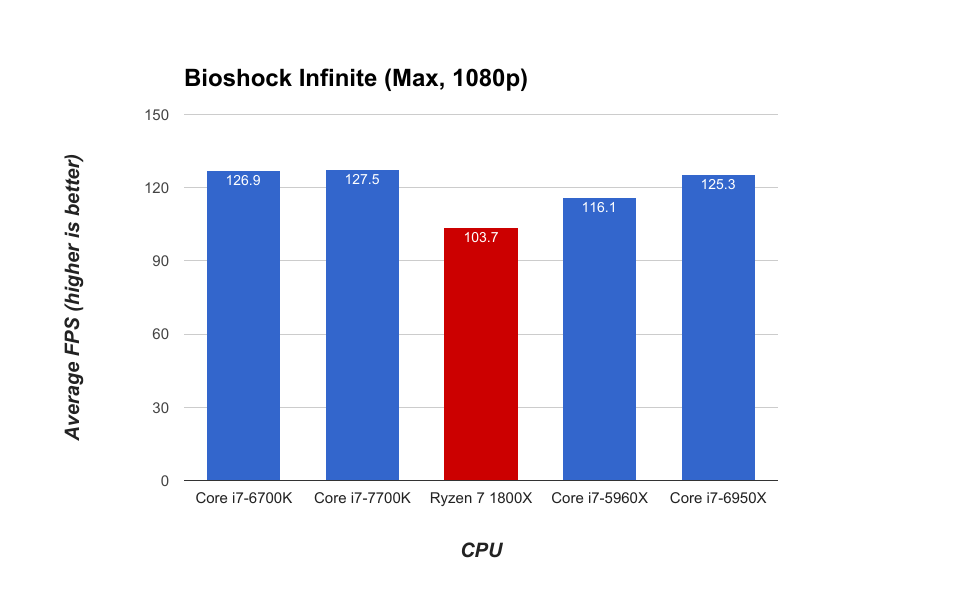
Again, the 1800X comes in last place among the CPUs we tested. With Bioshock Infinite at maximum settings, the faster individual cores of the 6700K and 7700K prove to be more suited for in-game performance.
SteamVR
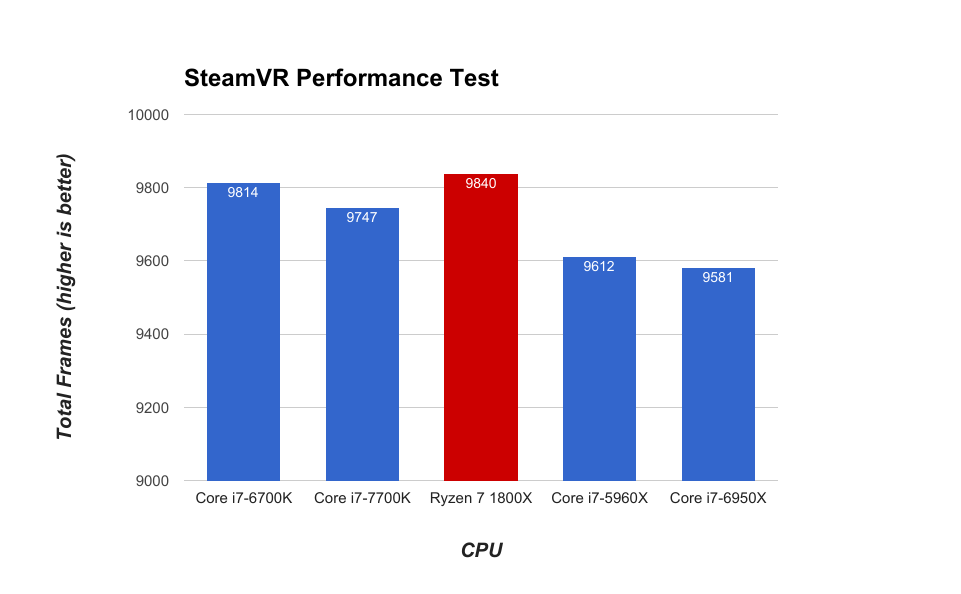
The Steam VR performance test is a benchmark tool to see if your system is ready for VR applications. AMD’s 1800X makes a bounces back by coming out on top, slightly outperforming all the Intel CPUs. The results between the Intel CPUs would tell us more cores aren’t necessary, but the 1800X would say otherwise. AMD attributes its VR performance to efficient single-threads.
Temperatures and Overclocking
Peak temperatures of the Ryzen 7 1800X were recorded during the X264 stress test since it is demanding multi-threaded nature make it a great worst-case scenario. With our Noctua air cooler, the peak core temperature was 74 degrees Celsius under load, which is a reasonable CPU temperature. This also means we had room for overclocking.
Keep in mind that the Ryzen 7 1800X will bounce between its 3.6GHz stock clock and 4.0GHz boost clock on its own, based on operating temperature and workload.
Using AMD's own Ryzen Master software, we were able to hit a stable 4.1GHz overclock with 1.45 volts while running X264. Peak load temperatures reached 82 degrees Celsius and the overclock returned modest results; around four percent for X264 Pass 1 and about six percent for X264 Pass 2.
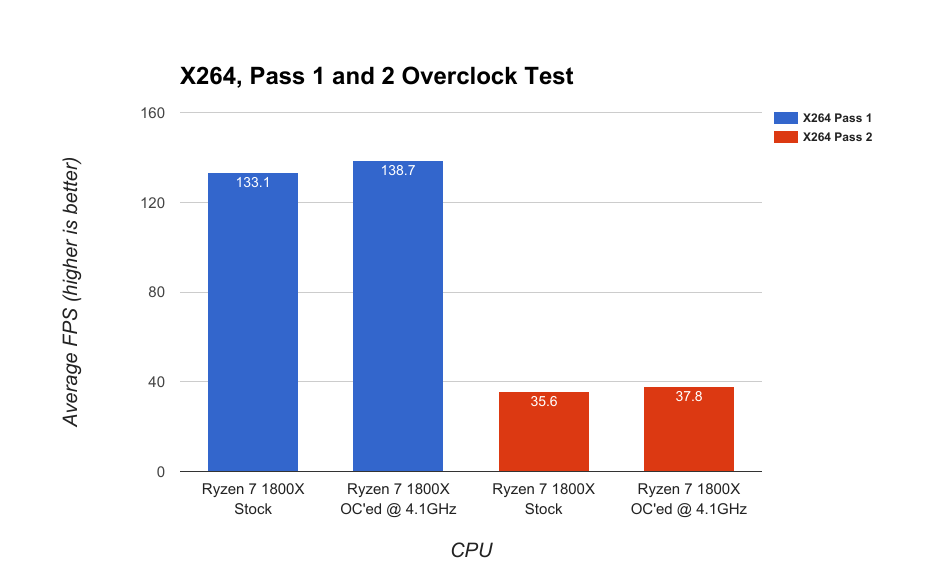
A more robust cooling solution and further tinkering may yield better overclocking results, which is worth exploring in future testing.
Conclusion
The bottom line is that the Ryzen 7 1800X makes the most sense for users that need more than a CPU for gaming, those who are considered “prosumers.” The performance for multicore applications is impressive for its $499 price tag, which increases accessibility for those who need more power for video production and image rendering.
The 1800X isn’t intended for those with only gaming on their mind, as most games benefit more from individual core speed. However, we’re curious as to why it substantially underperforms in our two game tests. Further in-game tests may or may not tell a different story, but future BIOS updates could help. Our 3DMark 11 and Steam VR benchmarks do show promise for Ryzen’s in-game performance, though. Regardless, the 1800X is one of the best bang-for-the-buck CPUs when it comes to applications--video encoding, image rendering, compression/decompression--that utilize more than four cores.
We plan to expand our in-game benchmark tests as we dig deep into the performance of the Ryzen 7 1700X and 1700 CPUs. Stay tuned for our breakdown of the new line of AMD processors.
